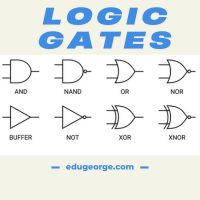LOGIC GATES
Logic gates are the fundamental building blocks of digital integrated circuits. Most logic gates take an input of two binary values and output a single value of a 1 or 0. Some circuits may have only a few while others such as a microprocessor may have millions of them. There are seven different types of logic gates, but we shall consider the first 3 known as the “STANDARD LOGIC GATES”.
TYPES OF LOGIC GATES
There are three standard single logic gates known as the simple gates.
They are:
- AND gate
- OR gate
- NOT gate
AND gate:
An AND gate is a logic gate that expresses an output 1, when all input is 0. When one of the input is 0 and the other is 1 output is usually 0.
Mathematically, AND gate stands for multiplication, i.e. when there are two inputs, M and G with an equal output Z, thus implies that:
Z = M.G or Z = M*G
For instance,
If M = 1 and G = 1
M = M AND G = 1 * 1 = 1
OR
If M = 0 and G = 1
M AND G = 0 * 1 = 0
OR gate:
OR gate is a logic gate that expresses an output as 1 if either or both of the inputs is 1. Whenever both inputs are 0, the output is usually 0.
Mathematically, OR gate stands for addition, i.e. when there are two inputs M and G, which is equal to an output Z, thus implies that:
Z = M + G
For instance:
If M = 1 and G = 1
M OR G = 1 + 1= 1
OR
If M = 0 and G = 0
M OR G = 0 + 0 = 0
NOT gate (Inverter gate):
Inverter is another name for NOT gate. Not gate is a logic gate that expresses a reversed output from the input given. It has only one input and the output is the inverse of the input. To express NOT gate mathematically, thus implies that:
Output Z = M
For instance:
If Z = 0
NOT Z = 1
OR
If Z = 1
NOT Z = 0
That means, the output is the inverse of the input.






